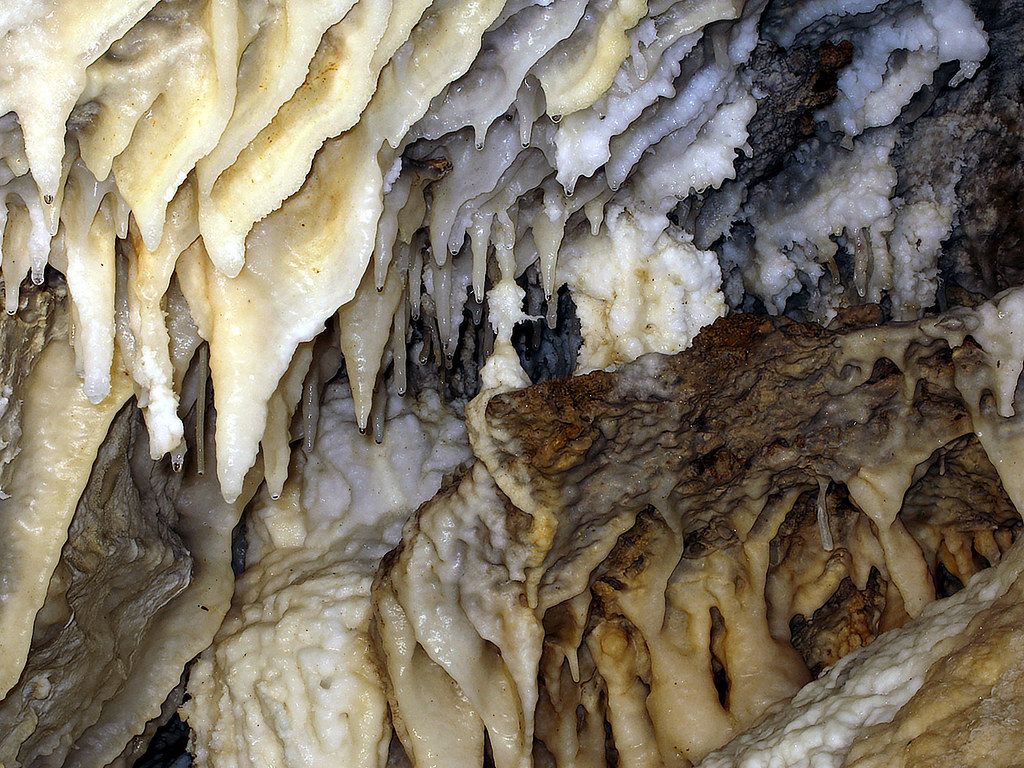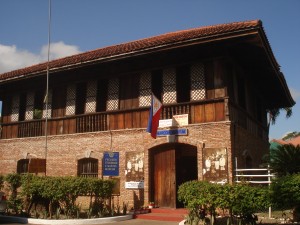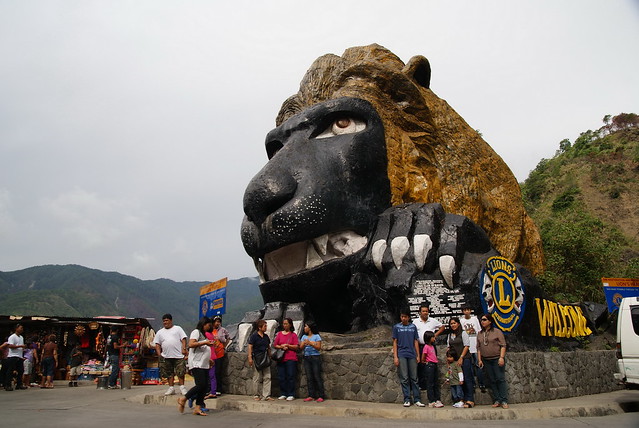Luzon is the largest and most economically and politically important island in the Philippines. It is also the name for one of the three island groups in the country centred on the Island of Luzon, the other two being the Visayas and Mindanao. Luzon as an island group includes the island of Luzon itself, plus the Batanes and Babuyan groups of islands to the north, and the main and outlying islands of Catanduanes, Marinduque, Masbate,Romblon and Mindoro in the south. It is home to the capital city, Manila.
The island of Luzon contains 8 of the 17 administrative regions of the Philippines. These regions are not political entities, but merely serve as administrative groupings of provinces. They are:
- Ilocos Region (Region I),
- Cagayan Valley (Region II)
- Central Luzon (Region III)
- CALABARZON (Region IV-A)
- MIMAROPA (Region IV-B)
- Bicol Region (Region V)
- Cordillera Administrative Region (CAR)
- National Capital Region (NCR)
Ilocos Region (REGION I):
Ilocos Region (Region I) is on the northweast side of the island and faces South China Sea. The region is well known for its white sand coastline and rich history. Its provinces are Ilocos Norte, Ilocos Sur, La Union, and Pangasinan. The region's administrative centers is San Fernando City, La Union.
Ilocos Norte, it's capital is Laoag City and is located at the northwest corner of Luzon Island, bordering Cagayan and Apayao to the east, and Abra and Ilocos Sur to the south. Ilocos Norte faces the South China Sea to the west and the Luzon Strait to the north.
Ilocos Norte is noted for being the birthplace of former President Ferdinand E. Marcos, who led an authoritarian rule over the country during the latter half of his incumbency.
Ilocos Norte is also known as a northern tourist destination, being the location of Fort Ilocandia, an upper class hotel and beach resort famous among expatriates, and Pagudpud.
 |
| Laoag International Airport |
 |
| The Marcos Museum - Batac City, Ilocos Norte |
 |
| Fort Ilocandia Beach Resort and Casino - The sandy beach spans 2 kilometers. It also offers the only 5-star hotel in northern Philippines sprawling over 77 hectares of land. It is located in Laoag City and is a 10-minutes drive from the Laoag International Airport. |
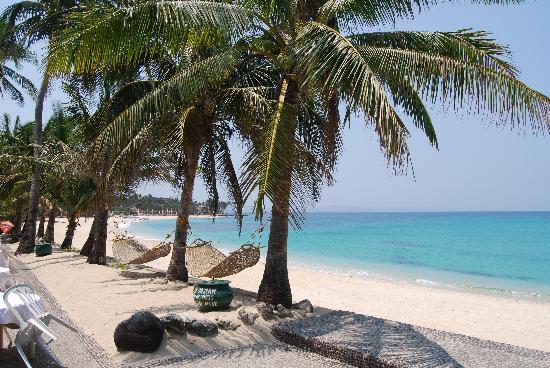 |
| Saud Beach Resort |
 |
| Laoag Sinking Bell Tower - Over the years the 45m high bell tower has shelved few meters downward. This is evident by the tower's entrance that at present day a man of ordinary height must bent over to get inside. |
 |
| Cape Bojeador Lighthouse - Cape Bojeador LightHouse was built in 1892 and is still functioning to date. The Cape Bojeador LightHouse still serves those ships passing by the Northern Part of the South China Sea. |
 |
| Paoay lake |
 |
| Bangui Windmills |
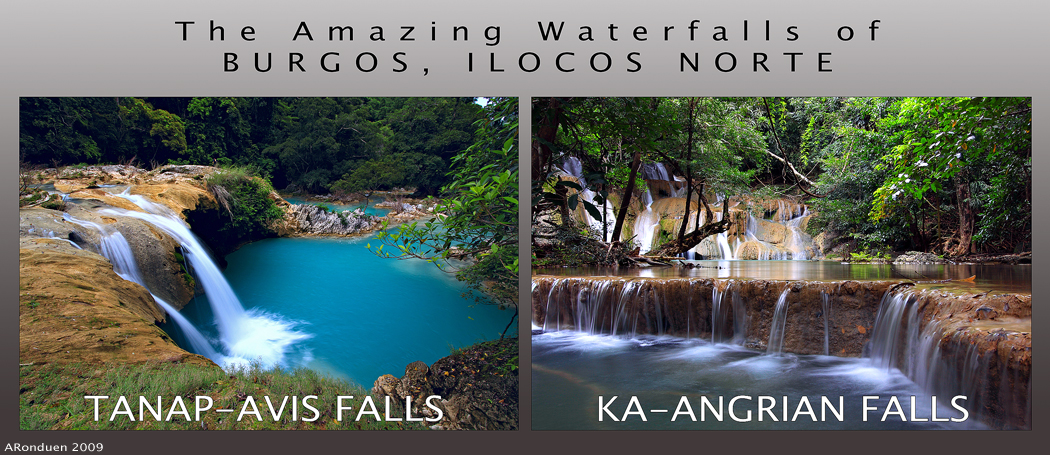 |
| Photo Credit: ARonduen |
Ilocos Sur
Vigan City, located on the mouth of the Mestizo River is the provincial capital. Ilocos Sur is bordered by Ilocos Norte and Abra to the north, Mountain Province to the east, La Union and Benguet to the south, and the South China Sea to the west.
Tourist Spots
Heritage City of Vigan - inscribed in the UNESCO World Heritage List, because it houses the most intact example of a Spanish colonial town in Asia. Other spots include pottery making and other forms of cottage industries. It also has hotels built in the "bahay na bato" ("stone house") style. Also located in the city is the residence of Father Jose Burgos, which is open to the public; and the Syquia Mansion, which is the Vigan residence of former President Elpidio Quirino.
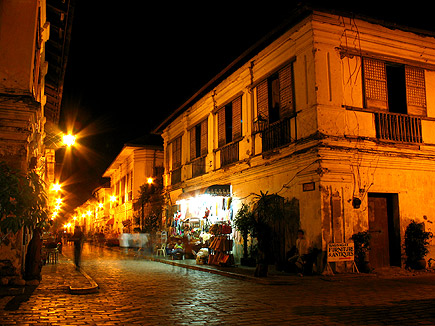 |
| Calle Crisologo at night, Vigan, Ilocos Sur |
 |
| St. Paul's Cathedral |
Some of the Beaches and Nature Spots in Ilocos Sur
 |
| Cabangtalan(in Sinait, also known as Imelda's Cove) |
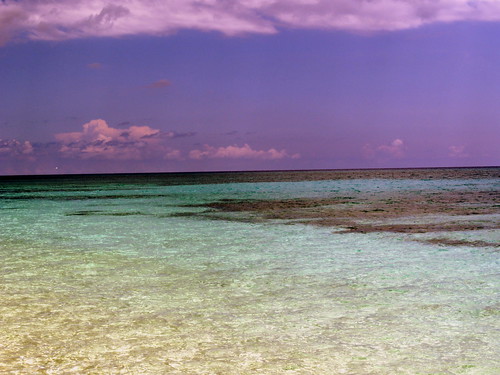 |
| Beach in Pug-os (Cabugao) |
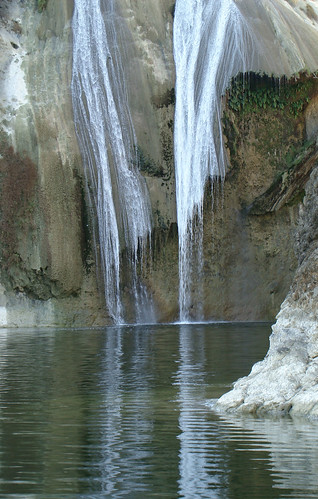 |
| Pinsal Falls - Barangay Babalasiwan, Sta. Maria. |
 |
| Sulvec Beach in Narvacan - A Groto on a Rock |
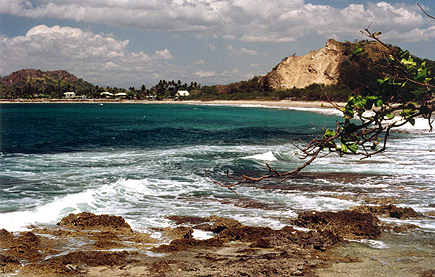 |
| Surf and corals at Santiago Cove |
 |
| Banaoang River in Bantay (an extension of the Abra River) |
La Union, capital is San Fernando City. Tourists often flock to the beaches of Bauang, or to the more secluded ones further north for snorkeling, surfing or other water sports; the more northerly beaches near San Juan specifically cater to both local surfers as well as portions of the world surfing circuit.
 |
| Bauang Beach |
 |
| La Union River Valley |
 |
| Bagulin Hanging Bridge |
 |
| Go surfing |
Pangasinan, the Hundred Islands, also located in the Northern Philippines, is a group of more than 400 islets with coral reefs surrounding the islets. These islands are famous for their beaches and the coral reefs, which can be explored by snorkeling. The provincial capital is Lingayen.
 |
| Hundred Islands |
 |
| Bolinao White Sand Beach Resort |
Cagayan Valley (Region II) is located in the northeast portion of the main island and also covers the Batanes and Babuyan islands to the north. The valley is surrounded by the Cordillera Centraland Sierra Madre mountain ranges. Running through its center is the country's longest river, Cagayan River. Its provinces are Batanes, Cagayan, Isabela, Nueva Vizcaya, and Quirino. The region's administrative centers is Tuguegarao City.
 |
| Callao Cave is the best known tourist attraction of Cagayan Province. It is located in Barangays Parabba and Quibal, in the town of Peñablanca, a thirty minute drive from the provincial capitol Tuguegarao. |
 |
| Imugan Falls in Nueva Viscaya |
 |
| Capisaan Caves |
 |
Cagayan Beach
(End of Cagayan Valley,REGION II) |
Central Luzon (Region III) contains the largest plain of the country and produces most of the country's rice supply. Its provinces are Aurora, Bataan, Bulacan, Nueva Ecija, Pampanga,Tarlac, and Zambales. The region's administrative center is the City of San Fernando, Pampanga. The former United States Navy base of Subic Bay is located in Subic, Zambales while the former United States Air Force is in Clark Field, Pampanga. Both are now two of the country's booming special economic zones. The main languages are Kapampangan and Tagalog.
Aurora Province
Beyond the lush forest of the Sierra Madre mountains lies a splendid land so unbelievably rich and untouched - Aurora, otherwise known as the “Sanctuary of Nature’s Splendor.”
Aurora is also famous among tourists for the:
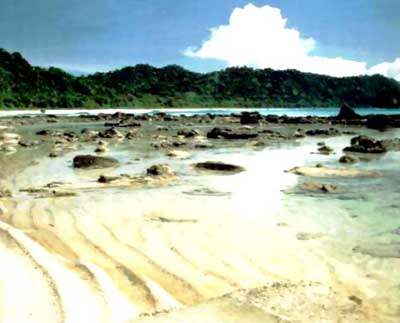 |
| Casapsapan Beach |
 |
| Baler Bay Surfing |
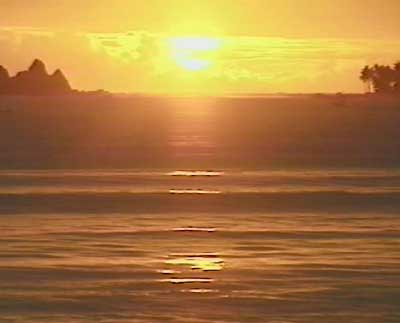 |
| Baler Bay Sunrise |
 |
| Dikasalarin View |
 |
| Ditumabo Falls |
 |
| Dingalan Lamao Caves |
Bataan is a province of the Philippines occupying the whole of the Bataan Peninsula on Luzon and the capital is Balanga City. The Battle of Bataan is famous in history as one of the last stands of American and Filipino soldiers before they were overwhelmed by the Japanese forces in World War II.
Bataan is also famous among tourists for the:
 |
| Corregidor, Bataan |
Pampanga Pampanga is a province located in the Central Luzon region. Its capital is the City of San Fernando, Pampanga.
North of Manila, take the rough road and go to Mt. Pinatubo, the volcano which caused a massive eruption in 1991. Now you can marvel at the volcano up close and swim inside its crater. The last eruption was one of the biggest during the last century and lowered the global temperature by at least a degree.
Pampanga is also famous among tourists for the:
 |
| Mt.Pinatubo Crater Lake |
 |
| Mt.Pinatubo Trekking |
CALABARZON (Region IV-A), one of the newest regions of the country, was previously a part of Southern Tagalog (Region IV). It is one of the most populous areas of the country. The name of the region is actually an acronym that stands for its provinces, which are Cavite, Laguna, Batangas, Rizal, and Quezon. The Tagalogs are the dominant ethnic group in this region, with Tagalog as the main language. Its recognized administrative center is Manila, which is in Metro Manila, however, some government officials still consider Quezon City, which is also in Metro Manila as the administrative center, and also, Lucena City.
Cavite is a province in the Philippines located on the southern shores of Manila Bay just 30 kilometers south of Manila.
Tourist Destination:
Tagaytay - 55 km (34 mi) away from Manila via Aguinaldo Highway
The City of Tagaytay is a second class city in the province of Cavite, Philippines.
Taal Volcano, one of the smallest active volcanoes in the world, sits on a lake and is just an hour away from Manila. The fresh cool air off the Tagaytay Ridge provides a spectacular view of the lake and the volcano. Visitors should confirm whether hiking to the crater is safe or not before attempting to do so.
 |
| Taal Volcano - Taal Lake |
 |
| People's Park In The Sky - An artful blending of natural and man-made attractions, poised on the highest point of Tagaytay City. |
 |
| Picnic Grove - The Zipline |
 |
| Picnic Grove - Tagaytay's playground is the popular Picnic Grove. It features huts line along the gentle slopes of the Tagaytay Ridge. It is a prime location, providing the finest view of the volcano far below. |
 |
| Tagaytay Highlands is a recreational and residential complex. |
 |
| Balite Falls, Brgy.Halang Cavite |
Laguna Its capital is Santa Cruz and the province is located southeast of Metro Manila. Laguna hugs the southern shores of Laguna de Bay, the largest lake in the country. The province is also notable for being the birthplace of Jose Rizal, the country's national hero.
Laguna is also famous among tourists for the:
 |
| Pagsanjan Falls |
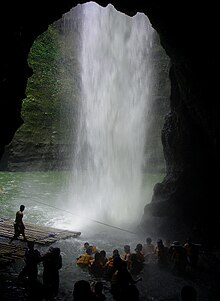 |
| Pagsanjan Falls |
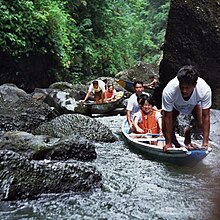 |
| Pagsanjan Falls, Pagsanjan Laguna |
 |
Pandin Lake, San Pablo City
|
Batangas is a first class province of the Philippines located on the southwestern part of Luzon. Batangas is one of the most popular tourist destinations near Metro Manila. The province has many beaches and is famous for excellent diving spots.
Batangas is also famous among tourists for the:
 |
| Diving Spot in Anilao Batangas |
 |
| Anilao, Batangas Coral Reef |
Rizal is just 16 kilometers east of Manila. Rizal is a mountainous province perched on the western slopes of the southern portion of the Sierra Madre mountain range.
Rizal is also famous among tourists for the:
 |
| Hinulugang Taktak, Antipolo Rizal |
 |
| St. Ursula Parish Church, Binangonan Rizal |
Quezon The province was named after Manuel L. Quezon, the second President of the Philippines, and its capital is Lucena City. A major tourism draw to the province is Mt. Banahaw. The mountain is surrounded by spiritual mysticism with many cults and religious organizations staying on the mountain. Numerous pilgrims visit the mountain especially during Holy Week.
Quezon is also famous among tourists for the:
Mt.Banahaw
MIMAROPA (Region IV-B), along with CALABARZON is the newest region of the country, and was previously a part of Southern Tagalog (Region IV). It contains most of the islands in the Luzon group. The name of the region is actually an acronym that stands for its provinces, which are Marinduque, Occidental Mindoro, Oriental Mindoro, Palawan and Romblon. The region's administrative center is Calapan City.
Bicol Region (Region V) occupies the Bicol Peninsula at the southeastern end of Luzon island, plus the outlying islands which include the island provinces of Catanduanes and Masbate. The remaining mainland provinces are Albay, Camarines Norte, Camarines Sur, and Sorsogon. The region's administrative center is Legazpi City. The inhabitants are of Bicolano descent with Bikol as the main language.
The Bicol Region or Bicolandia is one of the 17 regions of the Philippines.
The region has recently seen a revival in its tourism industry, due to the popularity of Mayon Volcano, the new CamSur Water Sports Complex, whale shark spotting, among others, which consequently increased the number of upscale resorts in the region.
Owing to its location, Region V offers plenty of choices for visitors - beautiful natural features like beaches, mountains and waterfalls with lush vegetation; activities could include scuba diving to wrecked galleons, spelunking, mountaineering; or visits to man-made attractions like church architecture from the Spanish Colonial Period; etc.
Bicol is also famous among tourists for the:
 |
| Mayon Volcano - The Perfect Cone |
 |
| Giant whale shark in DONSOL SORSOGON |
 |
| Visit Barcelona Church - check out St.Joseph Church in the town of Barcelona, a 19th century structure with walls made from huge slabs of stone taken taken from the sea cemented together using a unique mixture of beaten egg white, native coconut wine (tuba) and lime. |
 |
| Paguriran Lagoon of Bacon District, just half an hour from north of Sorsogon. |
 |
| San Juan Bautista Church (Tabaco Albay) |
 |
| Subic Island (Matnog, Sorsogon) |
 |
| Hoyop-Hoyopan Cave (Camalig, Albay) |
 |
| Tiking Island (Matnog, Sorsogon) |
 |
| CamSur - Wakeboarding |
Cordillera Administrative Region (CAR) almost completely covers the Cordillera Central mountain range of Northern Luzon. CAR, created in 1989 is a special administrative region for the indigenous tribes of these mountains. Its provinces are Abra, Apayao, Benguet, Ifugao, Kalinga, and Mountain Province. The regional center is Baguio City.
About two thousand years ago, mountains in Northern Luzon were carved by indigenous people to form what is now the Banaue Rice Terraces. The rice terraces cover 4,000 square miles (10,000 km2) of mountainside. The Banaue Rice Terraces is a UNESCO World Heritage site and is said to be the 8th wonder of the world.
The Hanging Coffins of Sagada and the Banaue Rice Terraces are worth a visit in the Northern Philippines. The rice terraces were carved out of mountains thousands of years ago and by far the most extensive of its kind in the world (longer and bigger than those in Indonesia) with sophisticated irrigation and engineering that was unthinkable during the time it was built.
 |
| Sagada Sumaging Cave |
Baguio, the city is known for its mild climate. It is because of this that Baguio is nicknamed the "Summer Capital of the Philippines". Owing to its high elevation, the temperature in the city is 8 degrees Celsius lower compared to the average temperature of the rest of the country.
The Famous Lion's Head of Baguio City
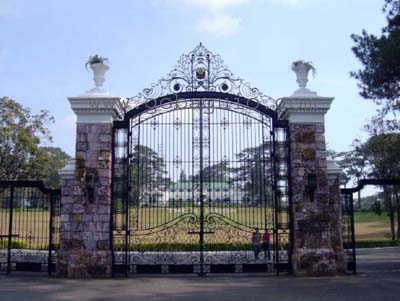 |
| Mansion House or The Mansion, as an official (second) residence of the President of the Philippines, entry to the compound is restricted. The public can view the Mansion through its gate, which is patterned after that of London's Buckingham Palace. |
 |
| Burnham Park, the oldest of all Baguio parks, it provides facilities for sporting activities such as biking, skating and basketball, as well as picnics and concerts. |
 |
| Wright Park, it is sometimes mistakenly called "Ride Park" by some tourists that identify this pine tree park reserve for horse rides. A long stairway leads to the "Pool of the Pines", a 100 meter long pool of water lined on both sides by the famous Baguio towering pine. |
 |
| Easter Weaving Room located within the campus of Easter School, this location allows tourists to witness the process of cloth weaving as has been practiced for ages by the natives of the mountain provinces. |
 |
| Strawberry Farm - Strawberry Picking, the rates for strawberry picking vary. In general, it costs twice the market price to pick your own strawberries. There's no minimum amount per person, they just weigh how much you all have picked together and you're charged for it. |
National Capital Region (NCR) is a special administrative region that contains the capital of the country, Manila; the country's most populous city, Quezon City; and an additional 15 more cities and municipalities. The region is more popularly known as Metro Manila. It is the only region in the country that has no provinces, and is the most densely populated with over 10 million people living in a 636 km² area.
Tagaytay
55 km (34 mi) away from Manila via Aguinaldo Highway
Taal Volcano, one of the smallest active volcanoes in the world, sits on a lake and is just an hour away from Manila. The fresh cool air off the Tagaytay Ridge provides a spectacular view of the lake and the volcano. Visitors should confirm whether hiking to the crater is safe or not before attempting to do so.
 |
| Taal Volcano - Taal Lake |
 |
| People's Park In The Sky - An artful blending of natural and man-made attractions, poised on the highest point of Tagaytay City. |
 |
| Picnic Grove - The Zipline |
 |
| Picnic Grove - Tagaytay's playground is the popular Picnic Grove. It features huts line along the gentle slopes of the Tagaytay Ridge. It is a prime location, providing the finest view of the volcano far below. |
 |
Tagaytay Highlands is a recreational and residential complex.
|



















